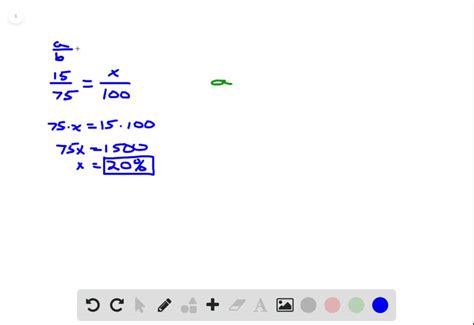What Percentage Of 75 Is 15
Kalali
Apr 03, 2025 · 4 min read

Table of Contents
What Percentage of 75 is 15? A Comprehensive Guide to Percentage Calculations
Calculating percentages is a fundamental skill in many areas of life, from finance and shopping to understanding statistics and scientific data. This comprehensive guide will not only answer the question "What percentage of 75 is 15?" but also equip you with the knowledge and techniques to solve similar percentage problems with ease. We'll explore various methods, from the basic formula to using proportions and even leveraging technology. By the end, you'll be a percentage pro!
Understanding Percentages: The Basics
Before diving into the specific problem, let's solidify our understanding of percentages. A percentage is simply a fraction expressed as a number out of 100. The symbol "%" represents "per cent," meaning "out of one hundred." For instance, 50% means 50 out of 100, or 50/100, which simplifies to 1/2.
Method 1: The Basic Percentage Formula
The most straightforward method to determine what percentage of 75 is 15 involves using the basic percentage formula:
(Part / Whole) * 100% = Percentage
In our case:
- Part: 15 (the value we want to express as a percentage)
- Whole: 75 (the total value)
Let's plug these values into the formula:
(15 / 75) * 100% = 20%
Therefore, 15 is 20% of 75.
Method 2: Using Proportions
Proportions offer another effective way to solve percentage problems. A proportion is an equation stating that two ratios are equal. We can set up a proportion to find the percentage:
x / 100 = 15 / 75
Here, 'x' represents the percentage we want to find. To solve for 'x', we cross-multiply:
75x = 1500
Now, divide both sides by 75:
x = 20
Therefore, 15 is 20% of 75.
Method 3: Working with Decimals
Converting the fraction to a decimal can also be a valuable approach. Divide the part by the whole:
15 / 75 = 0.2
To express this decimal as a percentage, multiply by 100%:
0.2 * 100% = 20%
Again, we confirm that 15 is 20% of 75.
Practical Applications: Real-World Scenarios
Understanding percentage calculations is crucial in various real-world situations. Let's consider some examples:
Shopping and Discounts
Imagine a shirt originally priced at $75 is on sale for $15 off. Using our knowledge, we know this represents a 20% discount. This information helps consumers make informed purchasing decisions.
Financial Calculations
Percentage calculations are fundamental in finance. Calculating interest rates, profit margins, and tax amounts all rely on understanding percentages. For example, if you invest $75 and earn $15 in profit, your return on investment is 20%.
Data Analysis and Statistics
Percentages are ubiquitous in data analysis and statistics. Representing data as percentages allows for easy comparison and interpretation. For instance, if 15 out of 75 survey respondents prefer a particular brand, that translates to a 20% preference rate.
Scientific Applications
Many scientific fields use percentages to express concentrations, yields, and other crucial data points. Understanding percentages is therefore essential for interpreting scientific findings and conducting research.
Beyond the Basics: More Complex Percentage Problems
While the problem "What percentage of 75 is 15?" is relatively straightforward, let's explore how to tackle more complex scenarios:
Finding the Whole Given the Percentage and Part
What if you know that 20% of a number is 15, and you want to find the original number? We can modify the basic percentage formula to solve this:
Whole = (Part / Percentage) * 100
Substituting our values:
Whole = (15 / 20) * 100 = 75
This confirms our original number was 75.
Finding the Part Given the Percentage and Whole
Suppose you need to find 20% of 75. We can use the basic formula:
Part = (Percentage / 100) * Whole
Part = (20 / 100) * 75 = 15
This confirms that 20% of 75 is indeed 15.
Using Technology for Percentage Calculations
While manual calculations are valuable for understanding the underlying principles, technology can streamline the process. Calculators, spreadsheets (like Microsoft Excel or Google Sheets), and even many smartphones have built-in percentage functions. These tools can significantly speed up calculations, especially for complex problems.
Troubleshooting Common Mistakes
When working with percentages, several common errors can arise:
- Incorrect Formula Application: Ensure you're using the correct formula for the specific problem type.
- Decimal Point Errors: Be meticulous with decimal points when converting between decimals and percentages.
- Unit Inconsistencies: Ensure all units are consistent throughout the calculation.
Conclusion: Mastering Percentage Calculations
The ability to calculate percentages is a vital life skill with applications across numerous fields. This guide has provided a thorough explanation of how to determine what percentage of 75 is 15, using multiple methods and exploring various real-world applications. By understanding the underlying principles and employing different approaches, you can confidently tackle any percentage problem you encounter. Remember to practice regularly to hone your skills and become proficient in this essential mathematical concept. With practice and a solid understanding of the formulas and techniques, you'll master percentage calculations and confidently apply them in your daily life and professional endeavors.
Latest Posts
Latest Posts
-
Cuanto Es 95 Grados Fahrenheit En Centigrados
Apr 03, 2025
-
24 In Is How Many Feet
Apr 03, 2025
-
What Is 239k Miles From Earth
Apr 03, 2025
-
How To Find Diameter Of Cylinder
Apr 03, 2025
-
26 Inches Is How Many Cm
Apr 03, 2025
Related Post
Thank you for visiting our website which covers about What Percentage Of 75 Is 15 . We hope the information provided has been useful to you. Feel free to contact us if you have any questions or need further assistance. See you next time and don't miss to bookmark.
